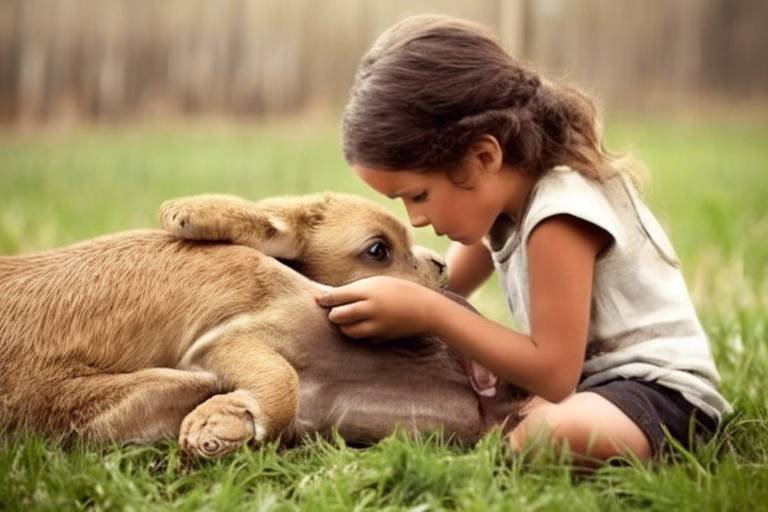How to Identify the Right Time to Adopt a Pet
Adopting a pet is one of the most exciting yet daunting decisions you can make. It’s like adding a new member to your family, and that comes with a whirlwind of emotions and responsibilities. But how do you know if you’re truly ready for this commitment? This article explores the various factors to consider before adopting a pet, including lifestyle, financial readiness, and emotional preparedness, helping potential pet owners make informed decisions. By the end, you'll have a clearer picture of whether it's the right time for you to open your heart and home to a furry friend.
Understanding your daily routine is crucial in determining if you can accommodate a pet. Think about it: if you’re constantly on the go, how will you manage the needs of a pet? Evaluate your work schedule, social life, and family dynamics to ensure a pet fits seamlessly into your life. For instance, if you work long hours or travel frequently, you might want to reconsider. Pets thrive on routine and companionship, so it’s essential that your lifestyle can support their needs.
Adopting a pet involves various costs, and it’s not just about the initial adoption fee. From food and vet visits to grooming and supplies, the expenses can pile up quickly. Analyze your financial situation to ensure you can provide for a pet's needs without compromising your budget. Here’s a quick breakdown of potential monthly costs:
| Expense | Estimated Monthly Cost |
|---|---|
| Food | $30 - $100 |
| Vet Visits (Routine) | $15 - $50 |
| Grooming | $20 - $60 |
| Supplies (Toys, Leashes, etc.) | $10 - $30 |
Make sure to factor in unexpected expenses too—like emergency vet visits. It’s always better to be prepared than to be caught off guard!
Consider your emotional readiness for the responsibilities of pet ownership. Reflect on your ability to provide love, attention, and care to a new pet, which is essential for their well-being. It’s not just about feeding them; it’s about creating a bond. Are you ready to be there for them during their ups and downs? Think of it like a relationship: it requires patience, understanding, and a whole lot of affection.
Pets require time and attention, from daily walks to playtime and training. Assess how much time you can realistically dedicate to a pet to ensure a fulfilling relationship. For example, dogs need daily exercise and mental stimulation, while cats may need less but still require interaction. If you find yourself too busy, perhaps consider a pet that demands less time or wait until you can fully commit.
Evaluate your living situation to determine if it’s suitable for a pet. Consider factors such as space, safety, and whether you have a pet-friendly environment to accommodate a new family member. If you live in a small apartment, a large dog may not be the best fit. Similarly, if you have young children, some breeds may be more compatible than others. It's essential to create a safe haven for your future pet.
Adopting a pet is a long-term commitment that can last many years. Think about your future plans and whether they align with the responsibilities of pet ownership. Are you planning to move? Change jobs? Start a family? Each of these factors can significantly impact your ability to care for a pet. It’s essential to consider how a pet fits into your long-term vision.
Different pets have varying needs and characteristics. Research various breeds and species to find one that matches your lifestyle and preferences, ensuring a harmonious relationship. For example, if you love to be active, a high-energy dog might be the perfect companion. On the other hand, if you prefer a more relaxed atmosphere, a cat or a small caged animal could be ideal. Invest time in understanding the specific requirements of the pet you’re considering.
If you live with others, it's essential to involve them in the decision-making process. Discuss pet adoption openly to ensure everyone is on board and understands the responsibilities involved. This isn’t just a personal decision; it’s a family affair! Make sure everyone is ready to contribute to the care and love that a pet requires.
Consulting with veterinarians or pet adoption agencies can provide valuable insights. They can guide you through the adoption process and help you determine if you’re ready for a pet. It’s like having a map for a journey—having someone experienced can make all the difference in ensuring you’re making the right choice.
- What is the best pet for a busy lifestyle? - Consider pets that require less attention, like fish or small rodents.
- How much should I budget for a pet? - On average, expect to spend $50 - $200 monthly, depending on the pet type.
- Can I adopt a pet if I rent my home? - It depends on your lease agreement; always check with your landlord first.
- What if I change my mind after adopting? - It’s crucial to be sure before adopting, but many shelters will help you find a new home for your pet if necessary.

Assessing Your Lifestyle
Understanding your daily routine is crucial in determining if you can accommodate a pet. Think about it: adopting a pet is like adding a new member to your family. You wouldn’t just bring someone home without considering how they fit into your life, right? So, let’s dive into what you need to evaluate.
First, take a close look at your work schedule. Do you work long hours? Are you often traveling for work? If you find yourself away from home for extended periods, a pet might feel neglected and lonely. Pets thrive on companionship, and being left alone frequently can lead to behavioral issues. On the flip side, if you have a flexible job or work from home, you might be in a great position to adopt a furry friend!
Next, consider your social life. Are you the life of the party, constantly out with friends, or do you prefer cozy nights in? If you’re out and about a lot, you’ll need to think about how that impacts your pet. Dogs, for example, need daily walks and interactions. Cats might be a bit more independent, but they still need attention and playtime. It’s all about finding the right balance that works for you and your future pet.
Family dynamics also play a significant role in this decision. If you live with others, it’s essential to assess how everyone feels about adopting a pet. Are your family members on board with the idea? Discussing this openly can prevent future conflicts and ensure that everyone is prepared for the responsibilities that come with pet ownership. Involving everyone in the decision-making process helps create a supportive environment for the new addition to your family.
Finally, think about your personal interests and hobbies. If you love outdoor activities, a dog that enjoys hiking or running might be the perfect companion. On the other hand, if you’re more of a homebody who enjoys quiet evenings, a cat or a small pet might suit your lifestyle better. The key is to align your interests with the type of pet you want to adopt to ensure a harmonious relationship.
In summary, assessing your lifestyle is about looking at the big picture. It’s not just about whether you want a pet; it’s about whether you can provide a loving and stable environment for them. By taking the time to evaluate your daily routine, work commitments, social life, family dynamics, and personal interests, you can make an informed decision that benefits both you and your future furry friend.

Financial Considerations
Adopting a pet is not just about the joy and companionship they bring into your life; it's also a significant financial commitment. Before you dive in, it's essential to evaluate your financial readiness to ensure that you can provide for your furry (or scaly) friend without breaking the bank. Think of it as budgeting for a new family member—because that's exactly what a pet is!
First and foremost, consider the initial costs associated with pet adoption. Many shelters and rescue organizations charge adoption fees, which can vary widely depending on the type of pet and the organization. These fees often cover vaccinations, spaying or neutering, and sometimes even a starter kit of supplies. For instance, the adoption fee for a dog might range from $50 to $300, while cats typically cost between $30 to $150. Here’s a simple breakdown:
| Type of Pet | Typical Adoption Fee |
|---|---|
| Dog | $50 - $300 |
| Cat | $30 - $150 |
| Rabbit | $20 - $100 |
| Bird | $10 - $200 |
Next, don't forget about the ongoing costs of pet ownership. These can include:
- Food: Depending on the size and dietary needs of your pet, you might spend anywhere from $20 to $100 a month.
- Veterinary Care: Routine check-ups, vaccinations, and unexpected health issues can add up. Budget at least $300 to $500 annually.
- Supplies: This includes everything from leashes and collars to toys and grooming products. Expect to spend around $100 to $200 initially.
- Pet Insurance: Consider investing in pet insurance to help mitigate veterinary costs, which can range from $20 to $60 monthly.
When you add it all up, the first year of pet ownership can easily exceed $1,000, and subsequent years can still cost several hundred dollars. It’s like planning for a new car or a home renovation—serious financial consideration is key!
Moreover, it's crucial to account for unexpected expenses. Pets can be unpredictable, and just like a toddler, they can get into trouble. Emergencies can arise, such as sudden illnesses or accidents, which may require immediate veterinary attention. Having a financial cushion or an emergency fund specifically for your pet can save you a lot of stress in the long run.
In summary, adopting a pet is a rewarding experience, but it comes with financial responsibilities that require careful planning. By evaluating your current financial situation and budgeting accordingly, you can ensure that you’re ready to welcome a new pet into your life without compromising your financial stability.
1. How much should I budget for my pet each month?
Typically, you should budget at least $100 to $200 each month for food, supplies, and routine veterinary care. This amount can vary based on the type of pet and its specific needs.
2. Are there any hidden costs of pet ownership?
Yes, hidden costs can include grooming, pet sitting, training classes, and emergency medical expenses. It's wise to account for these in your budget.
3. Can I adopt a pet if I’m on a tight budget?
While it’s possible to adopt a pet on a tight budget, you must ensure that you can still meet their basic needs. Consider looking into low-cost veterinary clinics and community resources for pet supplies.
4. Should I consider pet insurance?
Pet insurance can be a great way to manage unexpected veterinary costs. It’s worth researching different plans to find one that fits your budget and provides adequate coverage.

Emotional Preparedness
When it comes to adopting a pet, one of the most crucial factors to consider is your emotional readiness. This isn't just about having a soft spot for furry friends; it’s about understanding the commitment that comes with being a pet owner. Pets are not just animals; they become part of the family and require a significant amount of love, attention, and care. Have you ever thought about how much emotional energy you can dedicate to a new pet? It's a question worth pondering, as the answer can determine whether you’re truly ready for this responsibility.
Consider your current emotional state. Are you going through a major life change, such as a new job, moving to a new city, or experiencing personal challenges? These factors can impact your ability to provide the consistent love and attention that a pet needs. Just like a plant needs water and sunlight to thrive, pets require a stable environment where they can feel secure and loved. If your life feels like a whirlwind, it might be best to hold off on adopting until things settle down.
Moreover, think about the emotional impact that a pet can have on your life. While they can bring immense joy and companionship, they can also add stress and anxiety, especially during the initial adjustment period. It’s essential to be prepared for the ups and downs that come with pet ownership. Are you ready to deal with the occasional mess, the late-night howling, or the vet visits? If you can embrace these challenges, you are likely on the right path to being emotionally prepared.
Additionally, consider your ability to form a bond with a pet. This relationship is built on trust, affection, and understanding. You must be willing to invest time in getting to know your new companion, learning their quirks, and understanding their needs. Just like any relationship, it takes effort to cultivate a strong bond. Are you excited about the prospect of forming this connection, or does it feel like a chore? Your feelings can guide you in assessing your emotional readiness.
Finally, it’s important to reflect on your support system. Do you have friends or family members who can help you during the transition? Having a network of support can make a significant difference in your emotional preparedness. They can offer advice, lend a helping hand, or simply be there to share in the joy of pet ownership. If you feel isolated in your decision, it might be worth discussing your plans with loved ones to gauge their support.
In summary, emotional preparedness is about more than just wanting a pet; it’s about understanding the responsibilities that come with it. Take time to evaluate your current emotional landscape, your ability to form bonds, and the support you have around you. By doing so, you’ll set yourself up for a fulfilling and rewarding relationship with your future furry friend.
- What does emotional preparedness mean in pet adoption?
Emotional preparedness refers to your ability to provide love, attention, and care to a pet consistently. - How can I assess my emotional readiness for a pet?
Consider your current life situation, support system, and willingness to form a bond with a pet. - Can pets sense emotional readiness?
While pets may not understand human emotions as we do, they can pick up on your energy and mood, affecting their behavior and comfort.

Time Commitment
When it comes to adopting a pet, one of the most critical factors to consider is the required to ensure your new furry friend thrives. Pets are not just adorable companions; they are also living beings that need attention, love, and care on a daily basis. Imagine having a new family member who relies on you for everything from meals to exercise and social interaction. It's essential to assess how much time you can realistically dedicate to a pet without feeling overwhelmed or neglecting other responsibilities.
Pets require various types of time investments, including:
- Daily Care: Feeding, grooming, and cleaning up after your pet are daily tasks that cannot be overlooked. Depending on the type of pet you choose, this might take anywhere from 30 minutes to several hours each day.
- Exercise: Most pets, especially dogs, need regular exercise to stay healthy and happy. Daily walks, playtime, and training sessions are crucial. This could mean setting aside at least an hour a day for active play and exploration.
- Training: Training your pet is an ongoing process that requires patience and consistency. Whether it's teaching basic commands or socializing them with other animals, expect to invest time regularly, especially during the first few months.
- Social Interaction: Pets are social beings. They thrive on interaction, whether it's with you or other pets. Make sure you have time to engage with them, as loneliness can lead to behavioral issues.
To help visualize the time commitment, consider the following table that outlines the average time needed for different types of pets:
| Type of Pet | Daily Time Commitment (Hours) | Weekly Time Commitment (Hours) |
|---|---|---|
| Dog | 2 - 4 | 14 - 28 |
| Cat | 1 - 2 | 7 - 14 |
| Rabbit | 1 - 2 | 7 - 14 |
| Fish | 0.5 - 1 | 3.5 - 7 |
As you can see, the time commitment varies significantly depending on the type of pet you choose. Dogs generally require the most attention, while fish may be less demanding. However, regardless of the pet, it's vital to ensure that you can provide the necessary time and effort to meet their needs. If you find yourself constantly busy or unable to dedicate time, it might be worth reconsidering your decision to adopt.
In conclusion, adopting a pet is a rewarding experience, but it comes with its fair share of responsibilities. Before diving in, take a moment to reflect on your current lifestyle and commitments. Are you ready to make a long-term investment in a pet's well-being? If the answer is yes, then you're on the right path to becoming a loving pet owner!
Q: How much time do I need to spend with my pet daily?
A: It varies by pet type, but generally, dogs require 2-4 hours, while cats and rabbits may need 1-2 hours. Fish require the least time, around 0.5-1 hour.
Q: Can I adopt a pet if I have a busy schedule?
A: Yes, but it's crucial to choose a pet that matches your lifestyle. Consider pets that require less daily interaction, like cats or small animals, if your schedule is tight.
Q: What if I travel frequently?
A: Frequent travelers should consider pets that require less daily attention or make arrangements for pet care, such as hiring a pet sitter or using boarding facilities.

Home Environment
When it comes to adopting a pet, your plays a crucial role in ensuring a smooth transition for both you and your new furry (or scaly) friend. Imagine bringing home a lively puppy only to realize that your apartment is too small for them to run around. Or consider adopting a curious cat, only to find that your house is filled with fragile decorations that they might knock over. It's essential to assess your living situation carefully before making this big decision.
First and foremost, think about the space you have available. Pets, especially dogs, often require room to roam and play. If you live in a compact apartment, a smaller breed or a cat might be a better fit. On the other hand, if you have a spacious backyard, you might consider adopting a larger breed that needs more exercise and space to explore. It's like choosing the right size of a canvas for your masterpiece; the right environment allows for a vibrant, happy life.
Safety is another paramount concern. Pets are naturally curious creatures, and they love to explore their surroundings. Therefore, you should conduct a thorough inspection of your home. Look for potential hazards such as:
- Exposed electrical cords
- Small objects that could be swallowed
- Plants that are toxic to pets
- Open windows or balconies that could pose a risk
Creating a pet-friendly environment means removing these dangers and ensuring your home is a safe haven for your new companion. Think of it as creating a cozy nest where your pet can thrive, just like how you would prepare a nursery for a newborn.
Furthermore, consider whether your home has the necessary amenities for a pet. For instance, do you have a designated area for feeding and sleeping? Pets thrive on routine, and having a specific spot for their meals and rest can help them feel secure. You might even want to set up a small play area with toys and scratching posts (for cats) to keep them entertained. It’s akin to creating a personal playground for your child, where they can feel happy and engaged.
Finally, think about your future plans. If you anticipate moving in the near future, it’s essential to consider how your next home will accommodate a pet. Not all rental properties or neighborhoods are pet-friendly, so it’s wise to factor this into your decision-making process. Adopting a pet is not just about the present; it’s about envisioning a future where your pet can grow and thrive alongside you.
In summary, evaluating your home environment is a vital step in the pet adoption journey. By ensuring your living space is safe, spacious, and suitable for a pet, you set the stage for a fulfilling and joyful companionship. Remember, adopting a pet is like welcoming a new family member; you want to make sure they feel right at home from day one.
Q: How do I know if my home is suitable for a pet?
A: Assess the space, safety, and amenities in your home. Ensure there’s enough room for the pet to move around, and remove any potential hazards.
Q: What should I do if I live in a small apartment?
A: Consider adopting smaller breeds or pets that require less space, like cats or small dogs. Ensure you provide enough stimulation through playtime and exercise.
Q: Are there specific pet-friendly home modifications I should consider?
A: Yes! You can invest in pet gates, scratching posts, and designated feeding areas. Make sure to secure any hazardous materials or plants that could harm your pet.

Long-Term Commitment
Adopting a pet is not just a fleeting decision; it’s a that can span many years, often ranging from 10 to 20 years or more, depending on the type of animal you choose. Imagine bringing home a furry friend who will rely on you for love, care, and companionship throughout their life. This is not just about a cute face or a wagging tail; it’s about being there for them through thick and thin. So, before you rush into this decision, take a moment to reflect on your future plans and how they align with the responsibilities of pet ownership.
Consider your lifestyle ten years down the line. Will you still be in the same job? Will you be moving to a different city or starting a family? These factors can significantly impact your ability to care for a pet. For instance, if you plan to travel frequently or relocate for work, think about how that will affect your pet. Are you prepared to make arrangements for their care during your absences? It’s essential to have a plan in place to ensure your pet remains happy and healthy, no matter what life throws your way.
Moreover, the emotional and financial aspects of pet ownership can evolve over time. Just like humans, pets experience changes in health and behavior as they age. This means you’ll need to be ready for potential unexpected expenses, such as veterinary bills for chronic conditions or emergency treatments. It’s wise to set aside a budget specifically for your pet’s needs, so you’re not caught off guard when the unexpected happens.
To give you a clearer picture, here’s a simple table showcasing the potential lifespan of various common pets along with their average yearly costs:
| Type of Pet | Average Lifespan (Years) | Average Yearly Cost ($) |
|---|---|---|
| Dog | 10-15 | 1,000 - 2,000 |
| Cat | 12-20 | 800 - 1,500 |
| Rabbit | 8-12 | 500 - 1,000 |
| Parrot | 20-50 | 1,500 - 3,000 |
As you can see, different pets come with varying lifespans and costs, so it’s crucial to choose one that fits your long-term vision. Additionally, pets thrive on routine and stability. They need consistent care and attention, which means you’ll have to integrate them into your daily life. Think about how you can ensure they receive the love and attention they deserve, not just today but for years to come.
Finally, don’t forget that adopting a pet is like welcoming a new family member into your home. This means that everyone in your household should be on board with this commitment. Have open discussions about what it means to have a pet and how each member can contribute to their care. This shared responsibility can strengthen your family bond while ensuring a happy, healthy environment for your new furry friend.
- How long do pets typically live? - Lifespans vary by species; for example, dogs live around 10-15 years, while some parrots can live up to 50 years.
- What are the average costs associated with pet ownership? - Costs can range from $500 to $3,000 annually, depending on the type of pet and its needs.
- How can I prepare for unexpected pet expenses? - Setting aside a dedicated pet fund can help cover emergencies and routine veterinary care.
- What should I consider before adopting a pet? - Assess your lifestyle, financial readiness, emotional preparedness, and long-term plans.

Researching Pet Types
When it comes to adopting a pet, choosing the right type is just as important as deciding to bring one into your home. With so many options available, it can feel overwhelming, but don’t fret! Think of it like shopping for a new pair of shoes; you wouldn’t just grab the first pair you see, right? You want something that fits your style, budget, and lifestyle. The same goes for pets. Each type of animal comes with its own unique needs, personalities, and quirks, so doing your homework is crucial.
First, consider the energy level of the pet. For example, a high-energy dog breed, like a Border Collie, requires plenty of exercise and mental stimulation. On the other hand, a more laid-back cat, such as a British Shorthair, may be perfectly content lounging on the couch all day. Think about your own activity level. Are you a couch potato or a fitness enthusiast? This will help narrow down your choices.
Next, take a look at the space you have available. If you live in a small apartment, a large breed dog might not be the best fit. Instead, you might consider smaller pets like guinea pigs or cats that can thrive in tighter spaces. Conversely, if you have a large backyard and love the outdoors, a dog could be a great companion for your adventures.
Another factor to consider is allergies. If you or someone in your household suffers from allergies, you might want to research hypoallergenic pet options. Breeds like the Poodle or the Schnauzer are known to produce fewer allergens, making them suitable for allergy sufferers. It's essential to ensure everyone in your home can coexist comfortably with your new furry friend.
Don't forget about the lifespan of various pets. Some pets, like turtles or parrots, can live for decades, while others, like hamsters, have much shorter lifespans. It's important to think long-term and consider how your life might change over the years. Will you still be able to care for your pet as you grow older or if your family situation changes? This is a commitment that can last a lifetime, so make sure you're ready for it.
Lastly, I recommend visiting local shelters or pet adoption events. This not only gives you the chance to meet different types of pets but also allows you to get a feel for their personalities. Sometimes, the perfect match isn’t about the breed but the bond you form with an animal. Remember, adopting a pet is not just about choosing a type; it’s about finding a companion that fits seamlessly into your life.
- What is the best pet for a busy lifestyle? If you're often on the go, consider pets that require less attention, like fish or reptiles. Cats can also be independent and may be a good fit.
- How do I know if I’m ready for a pet? Assess your lifestyle, budget, and emotional readiness. If you can commit time and resources, you might be ready!
- Are there pets that are better for families with children? Breeds like Labrador Retrievers and Beagles tend to be very good with kids due to their friendly and playful nature.

Involving Family Members
When it comes to adopting a pet, involving your family members in the decision-making process is not just a good idea—it's essential! Think about it: bringing a furry (or scaly) friend into your home is a big step, and it’s crucial that everyone is on the same page. Imagine how chaotic it would be if one person is excited about the new addition while another is secretly dreading the extra responsibility. It’s like planning a surprise party where half the guests don’t want to celebrate!
Start by having an open discussion about the idea of adopting a pet. Share your thoughts and feelings about why you want to bring a pet into your lives. Is it for companionship, to teach kids responsibility, or simply because you love animals? Encourage your family members to express their opinions, too. This is a great opportunity to explore their feelings about pets, whether they’re excited, indifferent, or even hesitant.
To help facilitate this discussion, consider creating a pros and cons list together. This can be a fun and interactive way to weigh the benefits against the challenges of pet ownership. Here’s a simple example you can use:
| Pros | Cons |
|---|---|
| Companionship and love | Time-consuming care |
| Teaching responsibility (especially for kids) | Financial commitment |
| Encouragement for outdoor activities | Potential allergies |
It’s also vital to discuss who will take on specific responsibilities once you welcome a pet into your home. Will the kids help with feeding and walking? Will one partner take charge of vet visits? By clearly defining roles, you can avoid misunderstandings and ensure that everyone feels involved and responsible.
Moreover, consider involving family members in the adoption process itself. This could mean visiting shelters together to meet potential pets or researching different breeds that might suit your family’s lifestyle. Not only does this foster excitement, but it also helps everyone feel a sense of ownership over the decision. Plus, you’ll get to see how each family member interacts with different animals, which can be a great indicator of compatibility.
Lastly, remember that adopting a pet is a long-term commitment that will affect everyone in the household. By involving your family members from the start, you’re setting the stage for a harmonious relationship with your new pet. After all, a happy family leads to a happy pet!
- What should I consider before adopting a pet? Assess your lifestyle, financial situation, emotional readiness, and home environment.
- How can I involve my kids in the process? Have discussions, create pros and cons lists, and take them to shelters to meet pets.
- What are the costs associated with pet ownership? Consider food, vet visits, grooming, and supplies.
- How do I know if a pet is right for my family? Evaluate everyone’s feelings and responsibilities in caring for the pet.

Seeking Professional Advice
When contemplating the adoption of a pet, seeking professional advice can be a game-changer. Imagine trying to navigate a complex maze without a map—this is how many potential pet owners feel when considering the responsibilities of pet ownership. By consulting with professionals, you can gain invaluable insights that can help steer you in the right direction. Veterinarians and pet adoption agencies are not just there to sell you a pet; they are your partners in ensuring that you make a well-informed decision.
Veterinarians can provide a wealth of knowledge about the specific needs of different pets, including dietary requirements, health concerns, and behavioral traits. For example, certain breeds may have predispositions to specific health issues. Understanding these aspects can save you a lot of heartache and financial strain down the line. Additionally, they can help you gauge your readiness by discussing your lifestyle and how it aligns with the needs of the pet you are considering.
Pet adoption agencies are another fantastic resource. These organizations often have extensive experience in matching pets with potential owners. They can guide you through the adoption process, helping you understand what to expect and how to prepare your home for a new furry friend. They can also provide details about the pet's history, temperament, and any special needs they may have. This information is crucial for ensuring a smooth transition for both you and your new companion.
Furthermore, don't hesitate to ask questions! Here are some key questions you might consider asking during your consultations:
- What are the typical costs associated with this type of pet?
- What kind of training will this pet require?
- Are there any specific health issues to be aware of for this breed?
- What is the expected lifespan of this pet?
By engaging with professionals, you not only gather essential information but also show your commitment to responsible pet ownership. Remember, adopting a pet is not just about bringing home an animal; it’s about welcoming a new family member who will rely on you for their entire life. So, take the time to reach out and consult with those who know best. It’s an investment in the happiness and well-being of your future pet.
Q1: How do I know if I'm ready to adopt a pet?
A1: Assess your lifestyle, financial situation, and emotional readiness. Consulting with professionals can also help clarify your readiness.
Q2: What should I ask a veterinarian before adopting a pet?
A2: Ask about the pet’s health, dietary needs, and any breed-specific concerns. This will help you understand what to expect.
Q3: How can pet adoption agencies assist me?
A3: They provide guidance on the adoption process, help match you with the right pet, and offer insights into the pet's history and needs.
Q4: Is it necessary to involve my family in the decision to adopt?
A4: Absolutely! Involving family members ensures that everyone is on board and understands the responsibilities that come with pet ownership.
Frequently Asked Questions
- How do I know if I’m ready to adopt a pet?
Being ready to adopt a pet involves assessing your lifestyle, financial situation, and emotional preparedness. Take a moment to reflect on your daily routine, your ability to provide love and care, and whether you can afford the ongoing costs associated with pet ownership.
- What are the financial costs of adopting a pet?
The financial costs can vary significantly depending on the type of pet you choose. Generally, you should consider expenses like food, veterinary care, grooming, supplies, and potential emergency costs. It’s essential to create a budget that accommodates these ongoing expenses.
- How much time do I need to dedicate to a pet?
Pets require a considerable amount of time for daily care, including feeding, walking, playing, and training. Depending on the type of pet, you might need to dedicate several hours a day to ensure they are happy and well-adjusted. Assess your schedule to see how much time you can realistically commit.
- What should I consider about my home environment?
Your home should be a safe and welcoming place for a pet. Consider the size of your living space, whether you have a yard, and if your home is pet-friendly. Make sure to remove any hazards and create a comfortable area for your new furry friend.
- How do I involve my family in the decision to adopt a pet?
Discussing pet adoption with your family is crucial. Hold an open conversation about the responsibilities involved and ensure everyone is on board. It’s important that everyone understands their role in caring for the new pet to avoid future conflicts.
- What types of pets should I research before adopting?
Different pets have varying needs and temperaments. Research various breeds and species to find one that aligns with your lifestyle. Consider factors like energy levels, grooming needs, and compatibility with children or other pets.
- Should I consult professionals before adopting a pet?
Yes! Consulting with veterinarians or pet adoption agencies can provide you with valuable insights. They can help you understand the responsibilities of pet ownership and guide you through the adoption process, ensuring you make an informed decision.
- What if my lifestyle changes after adopting a pet?
Life can be unpredictable, and it’s essential to consider how changes might impact your ability to care for a pet. If you anticipate significant changes, think about how you can adapt your pet care routine or seek help from friends, family, or pet care services.



















